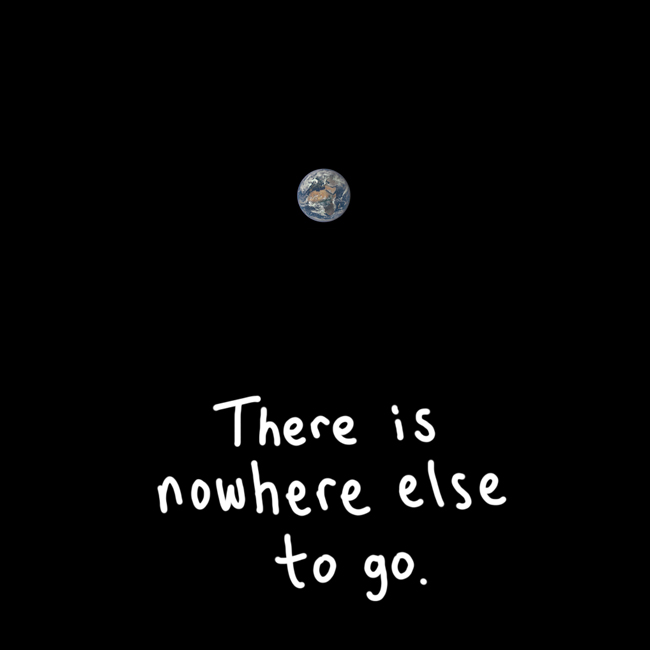Here are the last two years of measurements at the Mauna Loa CO2 sampling station:

In this graph, you can see that the annual minimum concentration of CO2 occurs in September (at the end of the boreal summer, when northern hemisphere trees wrap up their five months of carbon draw-down), and the maximum comes in May (as boreal summer begins and the photosynthesis fires up again). The big green number up top is yesterday’s measurement: 399.65 parts per million of our atmosphere are carbon dioxide.
During the Pleistocene “ice age,” this measurement (or its glacial air bubble proxy) varied between 180 and 280 ppm. It was at about 280 ppm prior to the Industrial Revolution. Since then, we’ve been taking carbon out of the ground, where it was sequestered hundreds of millions of years ago, and setting it on fire. The “free” energy we got from this chemical reaction has powered tremendous advancements in well-being of most humans living in industrialized societies. But the oxidation of carbon results in carbon dioxide, and though plants suck some of it up again, and the oceans absorb about a third of it, most continues to hang out in the atmosphere. Over the past two centuries, it has been piling up like dishes in a dormitory sink. This waste gas is a problem, for it’s selectively opaque to light – visible light is unfiltered by CO2, but CO2 blocks infrared wavelengths, the kind any object sitting in the sun emits long after the sun has set. That means our atmosphere retains more of the heat that would otherwise get bled off into space. Energy comes in more or less constantly from the sun, but less and less of it is making it back out.
Lockwood DeWitt called my attention today to the fact that this week is probably the last time you or me or anyone now alive on planet Earth will ever see concentrations of CO2 lower than 400 ppm. Ralph Keeling published a short piece about it, here. Unless something fundamentally changes in our relationship with the atmosphere (such as developing and deploying effective artificial carbon sequestration), the gas’s long-term accumulation will keep rising, and the planet will keep hanging on to a little more heat than it used to the year before. Though “400” is simply a round number with no inherent particular significance in and of itself, passing it for good seems a valid enough reason to pause for a moment and reflect on this massive thing we’re doing to our planet. Every additional increment of CO2 is likely to be a moderately long lived addition to our atmosphere. Its heat-trapping capacity is a major force driving our climate system into new, uncharted terrain for a long time to come. We depend on our climate. People we will never meet on the other side of the world do, too. Our children will depend on it. Grasshoppers and bluebirds and rattlesnakes and whales depend on it. Fungi depend on it. Grasses depend on it. Coccolithophores depend on it. And though this should be obvious, I’ll go ahead and say it explicitly: to a greater or lesser extent, we depend on them. Everything’s interdependent. We all live downstream – and we’re polluting that stream.
This planet is changing, and in many ways the changed Earth won’t be as hospitable to a lot of us who evolved in more stable times. The changed planet won’t be as comfortable for a lot of our neighbors, a lot of people we will never meet, not to mention non-human animals large, small, familiar, exotic, ecologically negligible, or ecologically essential. As a friendly reminder, if we screw the whole system up, we have limited real estate options:

Image modified from an original by NASA, here
We are beyond overdue in addressing this. A smart society would drive fossil fuels to extinction. We need to ramp up carbon-free sources of energy immediately and make them the cheaper economic choice by taxing the hell out of carbon power (coal, oil, and natural gas), and using that money to incentivize non-carbon energy sources instead. Our society has to set up a new system where it’s easy for people of limited means to eschew carbon. We are behaving stupidly by failing to deal with this problem, by continuing to reward those corporations which pursue their own profits (their only reason for existing) by damaging the world the rest of us live in. Given what we know about the Earth system’s physical components and the way they exchange energy, it is insane that we are letting this pro-carbon incentivization continue. Collectively, we are fouling our nest, and there are no other nests.
You may have come of age in a world where global carbon dioxide concentrations were less than 400 parts out of every million, but you don’t live in that world now, and you never will, ever again. What are you going to do about that? How high will you and I let this number climb?
